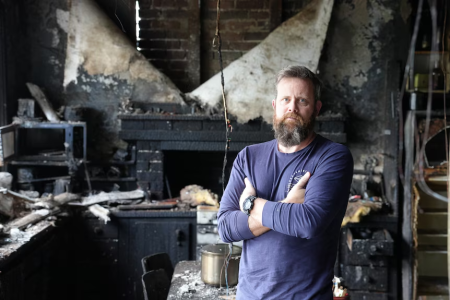Man who lost home in battery fire builds fireproof charging station
By
ABC News
- Replies 0
Amid calls for regulatory changes for lithium battery disposal, one man has taken matters into his own hands to safely store devices on charge.
On August 31 last year, Rodney Mulder put his laptop down and went to bed.
When he woke up at 1am, his children's bedrooms were engulfed in flames.
"Fortunately, my wife and kids were away that night, because [the children's bedrooms] were already on fire when I woke up," Mr Mulder said.
The cause of the blaze was deemed electrical, most likely the lithium battery powering his laptop, that was on charge as it rested on a cupboard near the couch.
The Mulder family home was destroyed and a fight for an insurance payout soon set in after an administrative error nearly cost them their coverage.
Not three weeks later, Mr Mulder was charging an iPad and the charging cable got so hot it melted.
One year on and after finally settling their claim with RAC, Mr Mulder is determined to prevent a similar tragedy from happening again.
Last month, he began the build of his new home, which will contain a fireproof space dedicated to charging devices and battery-powered products that he will build himself out of fibre concrete.
There are also some new house rules.
"I'll only be charging during daylight hours and when somebody is home," Mr Mulder said.
The managing director of Fire Forensics, a company which specialises in fire investigations, told the ABC it was often difficult to establish cause when lithium batteries were involved.
"It's really hard to scientifically determine if the failed lithium battery started the fire, or if it was affected by a fire and failed subsequently," Ms Jones said.
An increasing issue for firefighters
Even so, the Department of Fire and Emergency Services (DFES) has counted 113 lithium battery fires so far this year, with nine in the past 12 days alone.
"They contain a highly flammable material and cause intense and rapid spread of fire for our crews," DFES acting superintendent Mark Feast said.
Albany District Officer Cameron Famlonga said this made it difficult to save a structure from those fires.
"When a lithium-ion battery goes into thermal runaway, it does project cells and materials throughout a room," he said.
"It means the fire spreads through a room a lot more rapidly because there are multiple ignition points."
And it was not only appliances on charge that could be destructive.
"What's not well known is that there have been a high percentage of fires this year with batteries that have just been stored and not on charge," Mr Famlonga said.
"So it's a good idea to be storing batteries in metal boxes."
A major disposal problem
Waste and Recycling Industry of Western Australia CEO Michael Bobrowicz said there were about 30 fires in waste trucks and depots each week in WA.
"It's becoming an epidemic," he said.
"People driving those trucks are constantly looking in their rear-vision mirror and looking for empty parking lots to potentially dump a burning load."
The responsibility for battery disposal currently falls on the buyer but Mr Bobrowicz believes manufacturers need to take more responsibility for the product's full life cycle.
"The number one thing we don't want to see in general waste or recycling is batteries … when they get mixed up with other waste that is when the danger occurs," Mr Bobrowicz said.
The solution, he says, is extended producer responsibility, a policy framework that shifts responsibility for battery disposal from the consumer to the producer.
Ms Jones and Mr Bobrowicz both say there is no clear way for consumers to dispose of batteries safely as well as limited options to dispose of batteries.
Cheap power banks and batteries damaged by overcharging or being dropped are also repeat offenders.
Consumers can also do their bit to dispose of batteries responsibly with Bunnings, Woolworths and Officeworks offering convenient drop-off locations.
By Anna Cox, Paul Cook, Peter Barr and Samantha Goerling
On August 31 last year, Rodney Mulder put his laptop down and went to bed.
When he woke up at 1am, his children's bedrooms were engulfed in flames.
"Fortunately, my wife and kids were away that night, because [the children's bedrooms] were already on fire when I woke up," Mr Mulder said.
The cause of the blaze was deemed electrical, most likely the lithium battery powering his laptop, that was on charge as it rested on a cupboard near the couch.
The Mulder family home was destroyed and a fight for an insurance payout soon set in after an administrative error nearly cost them their coverage.
Not three weeks later, Mr Mulder was charging an iPad and the charging cable got so hot it melted.
One year on and after finally settling their claim with RAC, Mr Mulder is determined to prevent a similar tragedy from happening again.
Last month, he began the build of his new home, which will contain a fireproof space dedicated to charging devices and battery-powered products that he will build himself out of fibre concrete.
There are also some new house rules.
"I'll only be charging during daylight hours and when somebody is home," Mr Mulder said.
A safe option with 'violent' potential
Fire investigator Belinda Jane Jones says lithium batteries are seen as safe but "when they fail, they become quite violent".The managing director of Fire Forensics, a company which specialises in fire investigations, told the ABC it was often difficult to establish cause when lithium batteries were involved.
"It's really hard to scientifically determine if the failed lithium battery started the fire, or if it was affected by a fire and failed subsequently," Ms Jones said.
An increasing issue for firefighters
Even so, the Department of Fire and Emergency Services (DFES) has counted 113 lithium battery fires so far this year, with nine in the past 12 days alone.
"They contain a highly flammable material and cause intense and rapid spread of fire for our crews," DFES acting superintendent Mark Feast said.
"When a lithium-ion battery goes into thermal runaway, it does project cells and materials throughout a room," he said.
"It means the fire spreads through a room a lot more rapidly because there are multiple ignition points."
And it was not only appliances on charge that could be destructive.
"What's not well known is that there have been a high percentage of fires this year with batteries that have just been stored and not on charge," Mr Famlonga said.
"So it's a good idea to be storing batteries in metal boxes."
Waste and Recycling Industry of Western Australia CEO Michael Bobrowicz said there were about 30 fires in waste trucks and depots each week in WA.
"It's becoming an epidemic," he said.
"People driving those trucks are constantly looking in their rear-vision mirror and looking for empty parking lots to potentially dump a burning load."
The responsibility for battery disposal currently falls on the buyer but Mr Bobrowicz believes manufacturers need to take more responsibility for the product's full life cycle.
"The number one thing we don't want to see in general waste or recycling is batteries … when they get mixed up with other waste that is when the danger occurs," Mr Bobrowicz said.
The solution, he says, is extended producer responsibility, a policy framework that shifts responsibility for battery disposal from the consumer to the producer.
Ms Jones and Mr Bobrowicz both say there is no clear way for consumers to dispose of batteries safely as well as limited options to dispose of batteries.
What can consumers do in the meantime
For those not in a position to build a fireproof charging space, Ms Jones recommends people keep all charging devices in their line of sight and only use the charging cable that came with the product.Cheap power banks and batteries damaged by overcharging or being dropped are also repeat offenders.
Consumers can also do their bit to dispose of batteries responsibly with Bunnings, Woolworths and Officeworks offering convenient drop-off locations.
By Anna Cox, Paul Cook, Peter Barr and Samantha Goerling










